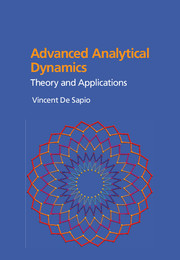Book contents
- Frontmatter
- Contents
- List of Illustrations
- List of Tables
- Preface
- Notation
- 1 Introduction
- 2 Mathematical Preliminaries
- 3 Kinematics of Discrete Systems
- 4 Conservation Principles
- 5 Zeroth-Order Variational Principles
- 6 First-Order Variational Principles
- 7 Second-Order Variational Principles
- 8 Dynamics in Task Space
- 9 Applications to Biomechanical Systems
- 10 Software for Analytical Dynamics
- Appendix Inclusion of Flexible Bodies
- References
- Index
1 - Introduction
Published online by Cambridge University Press: 02 February 2017
- Frontmatter
- Contents
- List of Illustrations
- List of Tables
- Preface
- Notation
- 1 Introduction
- 2 Mathematical Preliminaries
- 3 Kinematics of Discrete Systems
- 4 Conservation Principles
- 5 Zeroth-Order Variational Principles
- 6 First-Order Variational Principles
- 7 Second-Order Variational Principles
- 8 Dynamics in Task Space
- 9 Applications to Biomechanical Systems
- 10 Software for Analytical Dynamics
- Appendix Inclusion of Flexible Bodies
- References
- Index
Summary
Dynamics is traditionally defined as the classical study of motion with respect to the physical causes of motion, that is, forces and moments. Kinematics, on the other hand, is concerned with the study of motion without respect to the underlying physical causes. In this sense, kinematics is really a fundamental prerequisite upon which dynamics is constructed.
For the purposes of this text, the terms dynamics and mechanics are taken to be synonymous. The choice of which term is used is based more on the academic community than on a strict technical distinction. The engineering community typically adopts the term dynamics and the physics and applied mathematics communities typically adopt the term mechanics. The term dynamics is predominantly used in this text.
Historical Background
Interest in the dynamics of linked multibody systems has existed throughout much of recorded human history. As an example, representations of the human form in art have included anthropomorphic constructions made up of mechanical elements like those depicted in Giovanni Braccelli's Bizzarie di Varie Figure published in 1624 (see Figure 1.1). Braccelli's art coincided with the birth of the mechanical philosophy of René Descartes, Pierre Gassendi, and others. The mechanical philosophy sought to describe physical phenomena in terms of intricate mechanisms. Decades after the birth of the mechanical philosophy, a systematic theory of mechanics began to flourish with Newtonian mechanics.
Analytical dynamics (historically referred to as analytical mechanics) is identified with a number of formulations of classical mechanics that arose after Isaac Newton published his Philosophiae Naturalis Principia Mathematica in 1687. The cornerstones of Newtonian mechanics are his laws of motion, which were applied to point masses. From a modern perspective, Newton's second law can be seen more generally as a conservation law, specifically, as a law of conservation of momentum. As such, Newtonian mechanics, and its extension to extended (rigid) bodies by Leonhard Euler, are based on two fundamental conservation principles: (1) the conservation of translational momentum and (2) the conservation of angular momentum.
In contrast to the conservation principles underlying the Newton-Euler mechanics, the analytical dynamics that followed were based on variational principles. The conservation of vector quantities like translational and angular momentum was replaced with principles rooted in the variation of scalar quantities like work and energy.
- Type
- Chapter
- Information
- Advanced Analytical DynamicsTheory and Applications, pp. 1 - 9Publisher: Cambridge University PressPrint publication year: 2017



